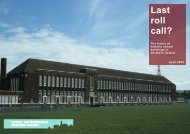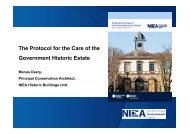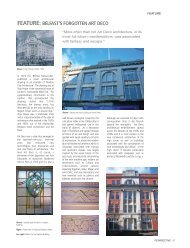Directory of Traditional Building Skills - Mourne Heritage Trust
Directory of Traditional Building Skills - Mourne Heritage Trust
Directory of Traditional Building Skills - Mourne Heritage Trust
Create successful ePaper yourself
Turn your PDF publications into a flip-book with our unique Google optimized e-Paper software.
11 REMEDIAL WORKS<strong>Building</strong> repair technology has become increasingly complex in recent years and there is aconfusing array <strong>of</strong> specialist systems designed to counteract rot, decay and damp. In manycases though, the temptation is to go for a technical solution when perhaps more basic,common-sense methods may be less destructive to the building’s fabric and occupants andequally effective. Retention <strong>of</strong> the maximum amount <strong>of</strong> original fabric must always be theguiding principle. Good remedial specialists should recommend the best system for eachindividual problem, but a few general guidelines may be useful.Damp pro<strong>of</strong> courses are rare in old buildings, although a layer <strong>of</strong> slate or bitumen is sometimesseen running through the wall. Rising damp is <strong>of</strong>ten caused when the ground level outside thebuilding is above the floor level inside and dampness is able to penetrate through the walls.Lowering the ground level and providing an external ‘french’ drain, a perforated pipe laid in agravel bed around the building to take away excess surface water, and putting in vents to allowventilation under suspended timber floors will generally alleviate the problem. Gentlebackground heating inside the house will help to dry out the walls. Most injected chemicalDPCs will only work on narrow brick walls. A typical rubble stone wall has voids and rubbishin its core and an injected DPC cannot form a continuous barrier, although specialist grouts areavailable for filling larger voids. Many old buildings have survived for hundreds <strong>of</strong> yearswithout a damp pro<strong>of</strong> course but if it is deemed necessary, the best option is an electro-osmoticsystem, where a titanium wire carrying a very low electric voltage is chased into the plasteraround the external walls. Results can be variable on very thick walls, but it is by far the leastdisruptive method and does not introduce potentially damaging chemicals into the fabric <strong>of</strong> thebuilding.Treatment for dry rot, woodworm and other fungal and insect attack is another controversialarea. The discovery <strong>of</strong> dry rot in particular is <strong>of</strong>ten accompanied by panic and hysteria. Theinjection <strong>of</strong> large quantities <strong>of</strong> toxic materials and hasty over-zealous remedial work hasresulted in the loss <strong>of</strong> many fine interiors. Dry rot will only survive in damp, warm conditionswhere there is little air movement, in badly ventilated floor voids and behind window shuttersfor example. If the source <strong>of</strong> the water is removed and the ventilation <strong>of</strong> fresh air improved thedry rot will die. There are few experts who will adopt such a studied yet simple approach.Insurance premiums and demands <strong>of</strong> mortgage companies <strong>of</strong>ten lead to radical stripping out <strong>of</strong>wholly unaffected timber and plaster which may well be unnecessary. A general change <strong>of</strong>attitude is long overdue. Good maintenance is the best remedy – gutters should be kept free <strong>of</strong>leaves and debris, broken downpipes and overflows repaired and pointing and flashings,especially on flat ro<strong>of</strong>s and in hidden valleys should be checked regularly. Wet rot andwoodworm are easily eradicated without great loss <strong>of</strong> original fabric.Repairs to chimneys can sometimes seem a black art rather than a scientific process. Flues inold houses were rarely lined and <strong>of</strong>ten ro<strong>of</strong> timbers were built into the chimney breast andexposed to smoke. Over the years these can become charred and in some instances cansmoulder without detection. This is one <strong>of</strong> the commonest causes <strong>of</strong> fires in old buildings,especially if modern closed high output fires burning high temperature smokeless fuel areintroduced. This type <strong>of</strong> fire and ‘coal effect’ gas fires must always have a lined flue. Insertinga flue liner into an old chimney and filling the voids with insulating material can be a dirty andawkward job and is best left to an expert. Even if the flue stays unlined for an open fire, it issensible to remove built in timbers, especially in thatched houses.126











